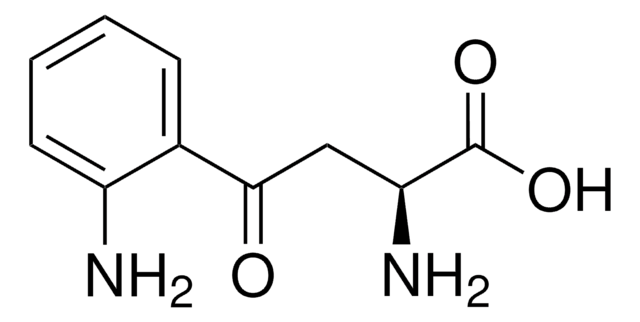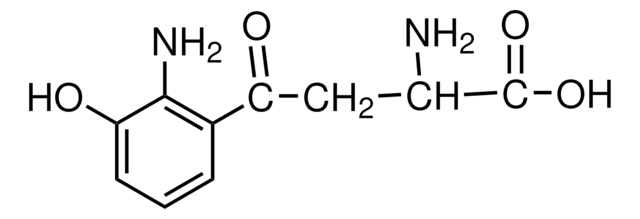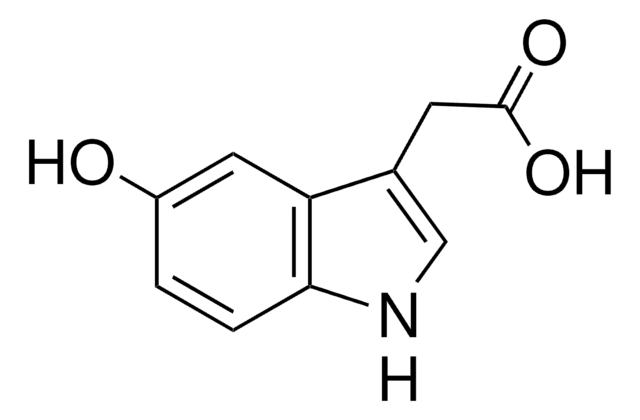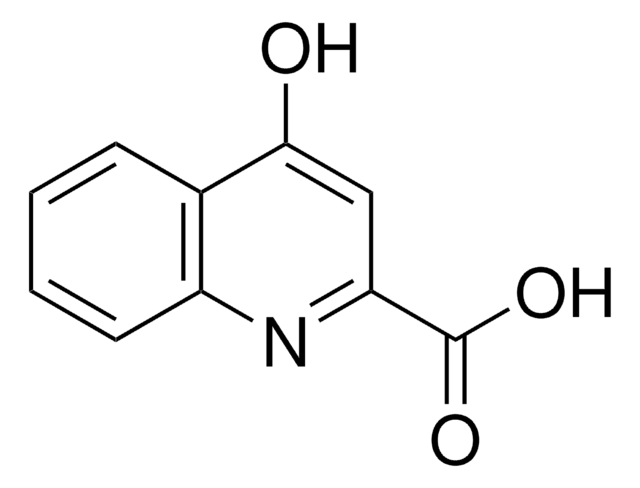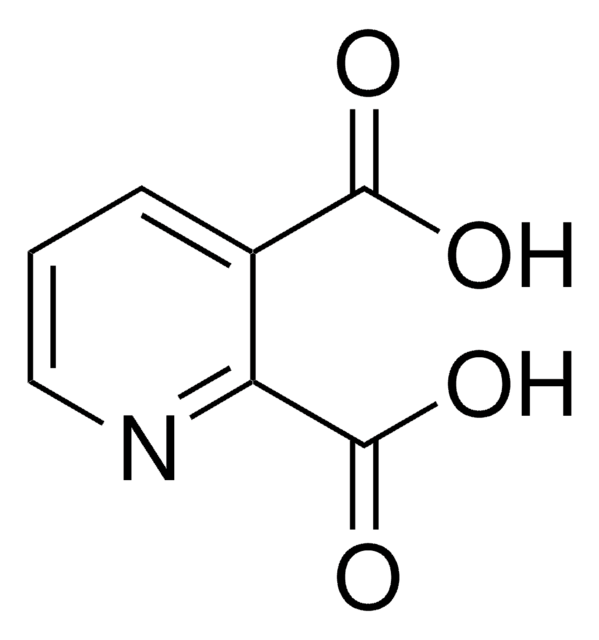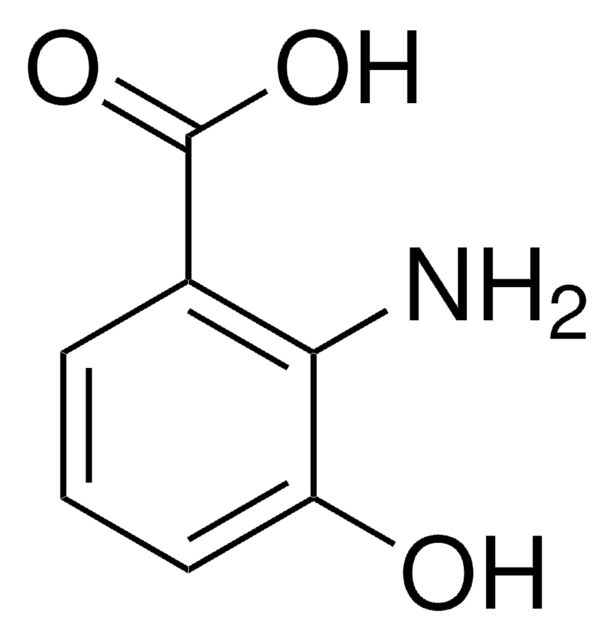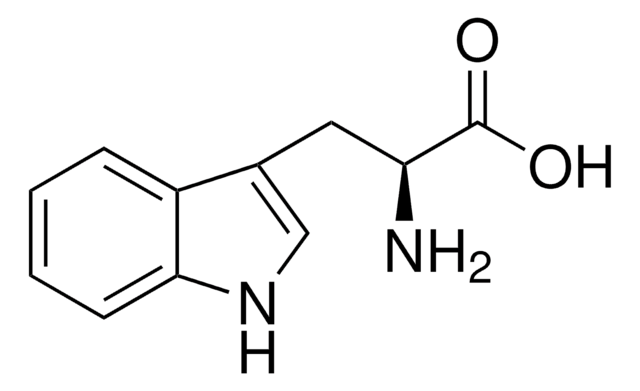추천 제품
Quality Level
분석
≥98% (HPLC)
양식
powder
저장 조건
desiccated
색상
red to very dark red
solubility
DMSO: ≥4 mg/mL
저장 온도
2-8°C
SMILES string
NC1=C(C(O)=O)C2=Nc3c(OC2=CC1=O)cccc3C(O)=O
InChI
1S/C14H8N2O6/c15-10-6(17)4-8-12(9(10)14(20)21)16-11-5(13(18)19)2-1-3-7(11)22-8/h1-4H,15H2,(H,18,19)(H,20,21)
InChI key
FSBKJYLVDRVPTK-UHFFFAOYSA-N
관련 카테고리
애플리케이션
Cinnabarinic acid may be used in studies of the functions of components of the kynurenine metabolic pathway. It may be used to study it role as a metabotropic glutamate receptor (mGlu4R-specific) agonist.
생화학적/생리학적 작용
Caspase Inducer; mGlu4R agonist
Caspase Inducer; mGlu4R agonist
Cinnabarinic acid (CA) connects between initiation of the kynurenine pathway and immune tolerance that is used to prevent neuroinflammation.
Cinnabarinic acid (CA) connects between initiation of the kynurenine pathway and immune tolerance that is used to prevent neuroinflammation.
Cinnabarinic acid is a kynurenine pathway metabolite of tryptophan, produced by the oxidation of 3-Hydroxyanthranilic acid. Cinnabarinic acid leads to loss of mitochondrial respiration and apoptosis, and has also been shown to be an mGlu4R-specific agonist.
특징 및 장점
This compound is a featured product for Apoptosis research. Click here to discover more featured Apoptosis products. Learn more about bioactive small molecules for other areas of research at sigma.com/discover-bsm.
Storage Class Code
11 - Combustible Solids
WGK
WGK 3
Flash Point (°F)
Not applicable
Flash Point (°C)
Not applicable
가장 최신 버전 중 하나를 선택하세요:
S Christen et al.
Biochemistry, 31(34), 8090-8097 (1992-09-01)
Since 3-hydroxyanthranilic acid (3HAA), an oxidation product of tryptophan metabolism, is a powerful radical scavenger [Christen, S., Peterhans, E., & Stocker, R. (1990) Proc. Natl. Acad. Sci. U.S.A. 87, 2506], its reaction with peroxyl radicals was investigated further. Exposure to
U Temp et al.
Applied and environmental microbiology, 65(2), 389-395 (1999-01-30)
When glucose is the carbon source, the white rot fungus Pycnoporus cinnabarinus produces a characteristic red pigment, cinnabarinic acid, which is formed by laccase-catalyzed oxidation of the precursor 3-hydroxyanthranilic acid. When P. cinnabarinus was grown on media containing cellobiose or
Hideaki Iizuka et al.
Biomedical chromatography : BMC, 24(3), 231-234 (2009-07-25)
A fluorimetric detection method for one of the tryptophan metabolites, cinnabarinic acid (CA), which has recently been reported to have the ability to induce apoptosis in thymocytes, was developed using o-tolyl hydrazine (TH) as the derivatization reagent. The carbonyl group
H Ogawa et al.
Hoppe-Seyler's Zeitschrift fur physiologische Chemie, 364(11), 1507-1518 (1983-11-01)
The formation of cinnabarinate in the presence of manganese ions and catalase was investigated spectrophotometrically. The absorption peak of cinnabarinate at 460 nm appeared only in a reaction system containing manganese ions and catalase. If catalase was omitted, a new
H Iwahashi et al.
The Biochemical journal, 251(3), 893-899 (1988-05-01)
Superoxide dismutase (SOD) enhanced the formation of hydroxyl radicals, which were detected by using the e.s.r. spin-trapping technique, in a reaction mixture containing 3-hydroxyanthranilic acid (or p-aminophenol), Fe3+ ions, EDTA and potassium phosphate buffer, pH 7.4. The hydroxyl-radical formation enhanced
관련 콘텐츠
Apoptosis, or programmed cell death (PCD), is a selective process for the removal of unnecessary, infected or transformed cells in various biological systems. As it plays a role in the homeostasis of multicellular organisms, apoptosis is tightly regulated through two principal pathways by a number of regulatory and effector molecules.
자사의 과학자팀은 생명 과학, 재료 과학, 화학 합성, 크로마토그래피, 분석 및 기타 많은 영역을 포함한 모든 과학 분야에 경험이 있습니다..
고객지원팀으로 연락바랍니다.